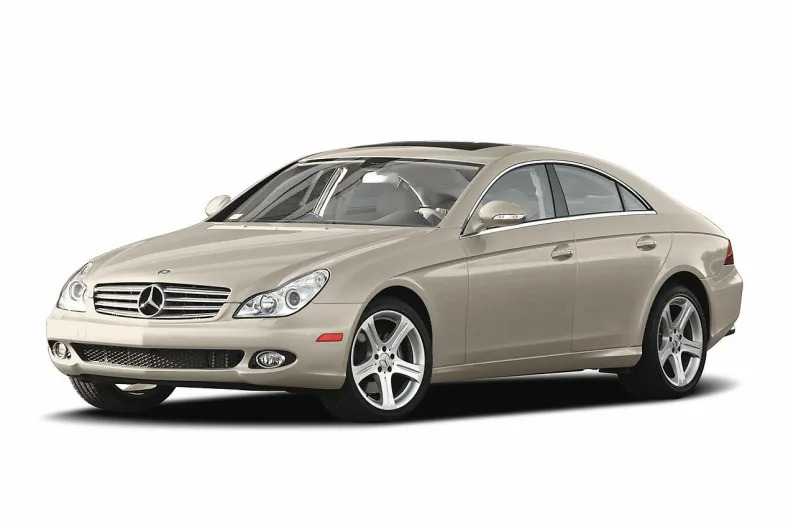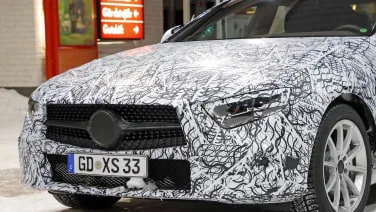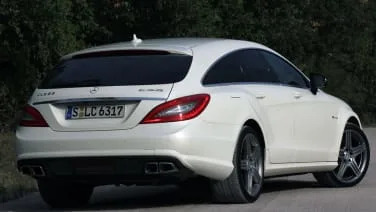2006 Mercedes-Benz CLS-Class
A slew of concept cars roll onto car show stands each year, but few earn the distinction of instant hit. The Mercedes-Benz 'Vision CLS' prototype was just that kind of car. When it appeared at Frankfurt two years ago, it was one of those rare projects that evoke immediate public acclaim, and Mercedes had little choice but to respond to the clamor and turn it into a striking new addition to the stable of the three-pointed star: the CLS. The Mercedes-Benz CLS is based on the E-Class platform, but only about 35 percent of the car's components are shared with other models. There's a little SL thrown in and the rest is pulled from the company's extensive parts bins, but this is no cobbled-together 'special' conspired one late night by a desperate marketing department. The CLS is not only a prime example of the company's technical acumen, but it has the looks to elevate it onto any list of the most beguiling Mercedes-Benzes ever crafted.
Let's dispel, from the start, any dispute over the car's nomenclature: Sedan, coupe, who cares what a car is called as long as it's appealing and fulfills its promise? In those respects, the CLS allows no equivocation: This swoop-roofed four-door coupe might use its handsome face to draw the eye and inflame our passions, but don't imagine the good looks render moot the qualities that make the CLS a thoroughly modern motorcar. That's not the way Mercedes builds its vehicles, no matter how pretty the wrapping. The company uses every new model to widen the application of its technology, refining systems on the run so as to ensure that the element of 'newness' reflects a better automotive experience.
This extends to every layer of the CLS. Even the paint is special. Using nano-technology, the clearcoat layer was impregnated with huge numbers of tiny ceramic particles, increasing resistance to scratches, says Mercedes, by 300 percent over conventional finishes. This virtually self-healing paint covers sheet steel (70 percent of which is galvanized) that includes high-strength alloys (47.5 percent by weight) and a so-called 'dual-phase' steel, used around the bumpers and suspension mounts as well as various other areas of the underbody, that was developed for high dynamic strength and resistance to extreme load forces.
The car's structure follows the current Mercedes method for all of its passenger cars, attaching separate front and rear modules to the main body structure. This both simplifies the production process and allows most accident repairs to be completed without the need for such extreme measures as welding in new components or structures. Extensive use of lightweight aluminum alloys and complex plastics are used to help keep the overall weight just below 4,000 pounds. It's also an aerodynamically efficient car despite its size, boasting a coefficient of drag of just 0.31. Helping it slip more easily through the air is a new plastic-clad underbody in place of the former PVC underbody protection. This new approach is more resistant to damage and also reduces …
Full Review
Full Review
The Mercedes-Benz CLS is based on the E-Class platform, but only about 35 percent of the car's components are shared with other models. There's a little SL thrown in and the rest is pulled from the company's extensive parts bins, but this is no cobbled-together 'special' conspired one late night by a desperate marketing department. The CLS is not only a prime example of the company's technical acumen, but it has the looks to elevate it onto any list of the most beguiling Mercedes-Benzes ever crafted.
Let's dispel, from the start, any dispute over the car's nomenclature: Sedan, coupe, who cares what a car is called as long as it's appealing and fulfills its promise? In those respects, the CLS allows no equivocation: This swoop-roofed four-door coupe might use its handsome face to draw the eye and inflame our passions, but don't imagine the good looks render moot the qualities that make the CLS a thoroughly modern motorcar. That's not the way Mercedes builds its vehicles, no matter how pretty the wrapping. The company uses every new model to widen the application of its technology, refining systems on the run so as to ensure that the element of 'newness' reflects a better automotive experience.
This extends to every layer of the CLS. Even the paint is special. Using nano-technology, the clearcoat layer was impregnated with huge numbers of tiny ceramic particles, increasing resistance to scratches, says Mercedes, by 300 percent over conventional finishes. This virtually self-healing paint covers sheet steel (70 percent of which is galvanized) that includes high-strength alloys (47.5 percent by weight) and a so-called 'dual-phase' steel, used around the bumpers and suspension mounts as well as various other areas of the underbody, that was developed for high dynamic strength and resistance to extreme load forces.
The car's structure follows the current Mercedes method for all of its passenger cars, attaching separate front and rear modules to the main body structure. This both simplifies the production process and allows most accident repairs to be completed without the need for such extreme measures as welding in new components or structures. Extensive use of lightweight aluminum alloys and complex plastics are used to help keep the overall weight just below 4,000 pounds. It's also an aerodynamically efficient car despite its size, boasting a coefficient of drag of just 0.31. Helping it slip more easily through the air is a new plastic-clad underbody in place of the former PVC underbody protection. This new approach is more resistant to damage and also reduces …
Hide Full Review
Retail Price
| Engine | 5.0L V-8, 5.5L V-8 |
| MPG | Up to 16 city / 22 highway |
| Seating | 4 Passengers |
| Transmission | 5-spd auto w/OD, 7-spd auto w/OD |
| Power | 302 - 469 hp |
| Drivetrain | rear-wheel |
| Curb Weight | 3,812 lbs |




![2015 Mercedes-Benz CLS400 [w/video]](https://edgecast-img.yahoo.net/mysterio/api/FE46DBEC04712EFFCC080607456DC01A10807285B3F62F0FD9141D16D123B80B/autoblog/resizefill_w376_h212;quality_85;format_webp;cc_31536000;/https://o.aolcdn.com/images/dims3/GLOB/crop/1787x1006+62+133/resize/376x212!/format/jpg/quality/85/http://o.aolcdn.com/hss/storage/midas/ddb105b058f56bcc6f88a021c4705387/201894754/2015-mercedes-benz-cls400-00.JPG)
